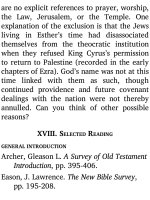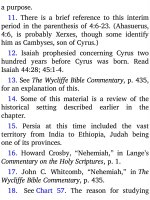Jensens survey of the old testament adam 405
Bạn đang xem bản rút gọn của tài liệu. Xem và tải ngay bản đầy đủ của tài liệu tại đây (152.24 KB, 4 trang )
chart is arrived at by comparing all four
gospels. No one gospel includes all the
events, but Luke’s gospel is regarded as the
most generally representative biography.
About half its material is not found in the
other gospels.
11. Scroggie has called these “the last of the
Hebrew Psalms, and the
rst of the
Christian hymns” (A Guide to the Gospels, p.
371).
12. The Latin title refers to the Bible text,
“now … let … depart.”
13. Actually, 1:1-4, an introduction to the
epistle, stands by itself.
This revelation of His nature is prominent
in John’s gospel, to be studied later.
15. For a list of parables and miracles found
only in Luke and of those found in all the
synoptic gospels, see W. Graham Scroggie, A
Guide to the Gospels, pp. 351-52.
16. W. Graham Scroggie, A Guide to the
Gospels, p. 380.
17. Stephen referred to Jesus this way (Acts
7:56).
18. Two recommended outside sources on
this subject are G. Campbell Morgan, The
Parables and Metaphors of Our Lord; and
Herbert Lockyer, All the Parables of the
Bible.
8John: Life in Jesus, the Son of God
About forty years after the rst New
Testament book was written, God inspired
the aged apostle John to compose the last of
the gospel accounts, known today as the
fourth gospel. In many ways it is distinct
from the other three gospels and serves as a
capstone revelation of the life and ministry
of Christ. Today it is often the rst New
Testament book recommended to new
Christians for study. That is because it has a
combination of many desirable features that
make it a primer for reading and study: it
clearly presents foundational truths; it
combines fact and interpretation; it presents
the way of salvation succinctly and
persuasively (e.g., 3:16); its very setting and
atmosphere are universal; and it is
picturesque and attractive in varied forms.
Some of those qualities will become evident
as you survey this fascinating portion of
Scripture.
I. PREPARATION FOR STUDY
1. First, think about why God would want
a fourth gospel written, since the
combination of the three that had been
written — Matthew, Mark, and Luke — was
so comprehensive and instructional. A
sweeping general view of the rst century,
involving the facts of the gospel, will
suggest some answers to the question. Study
Chart 40, observing the following:
a. The three words originate, recorded, and
interpreted identify each of the century’s
three periods.
b. The rst period (up to A.D. 33) is that of
the historical origins. For example: Jesus
was born; Jesus was cruci ed; Jesus was
resurrected.









